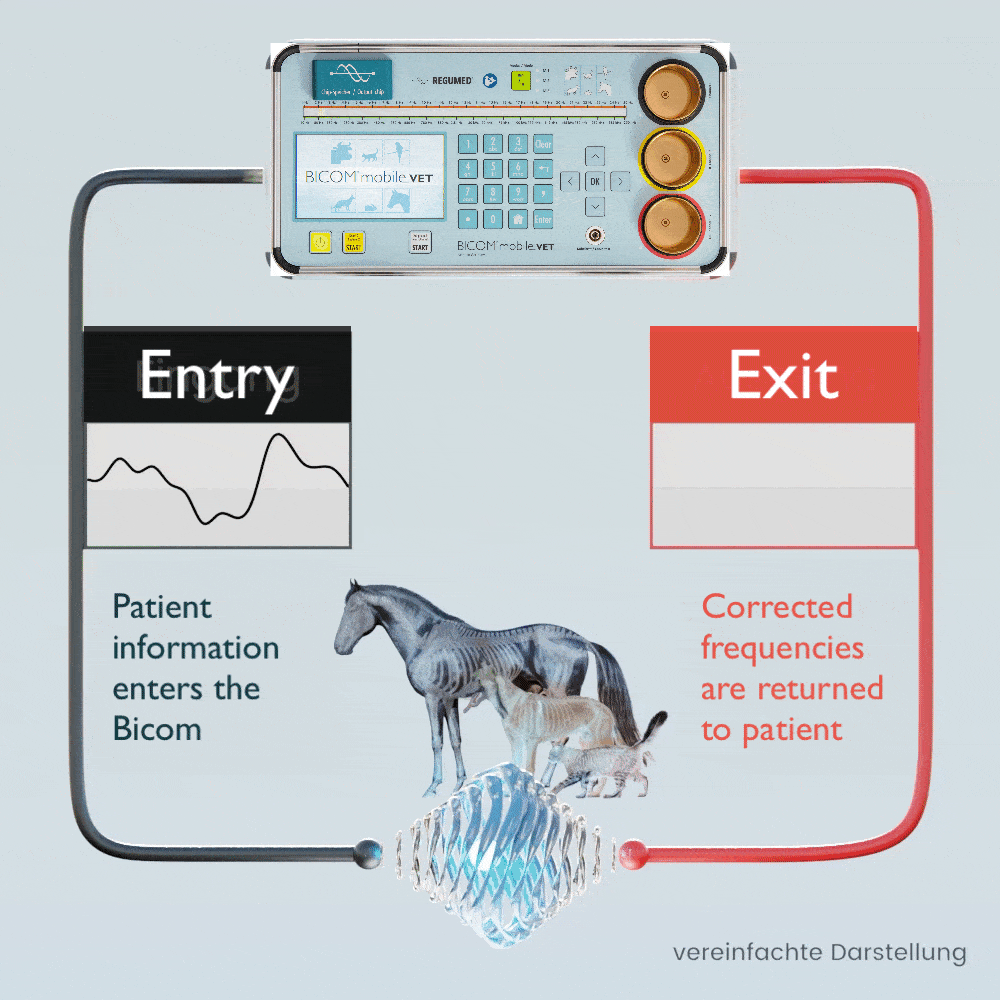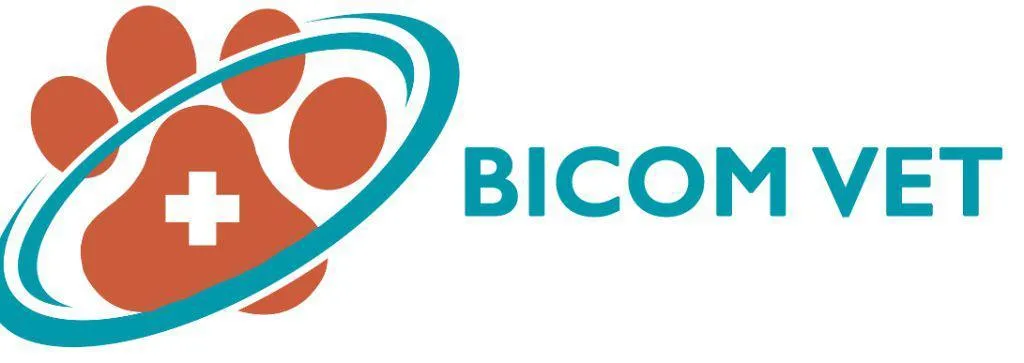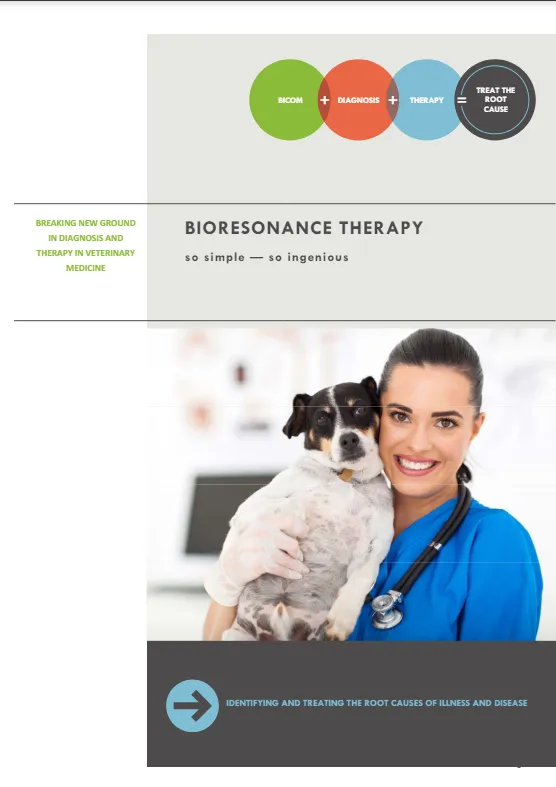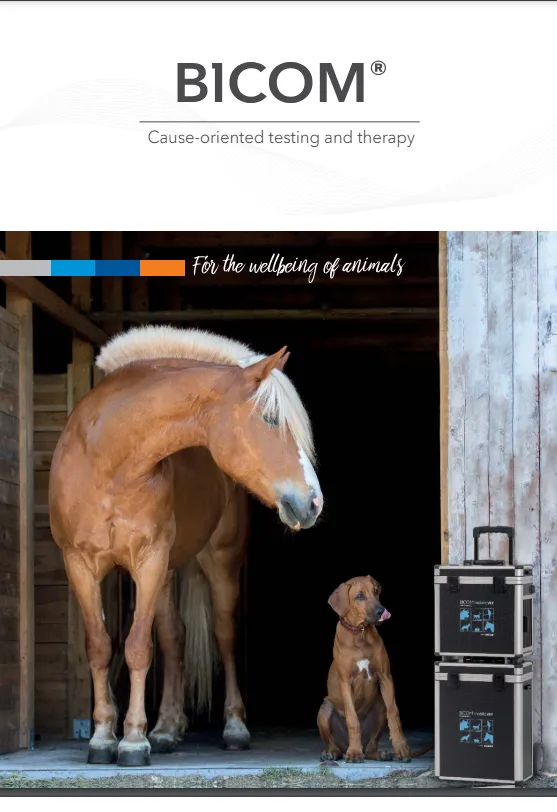Treatment with the help of the patient’s own information
in the BICOM® mobile VET bioresonance device
In contrast to other “frequency therapy devices”, BICOM® bioresonance is a method that is highly individual and perfectly tailored to the needs of the patient through the use of the patient’s own information and the possibility of testing specific wave patterns for resonance.
The patient’s own pathological and physiological information is recorded using special applicators and fed into the BICOM® mobile VET.
Depending on the therapy program, the specific wave pattern as a carrier of information is amplified, weakened or inverted and transmitted back to the patient in modulated form, which means that the transmission of information changes in clarity depending on the modulation or it disappears completely.
The treatment signals continuously adapt to the changing pathological situation of the patient. As the therapy progresses, the body’s ability to regulate is reactivated.
Find out more about this topic at our regular events. Together with veterinarians and animal naturopaths, we offer various face-to-face and online events .
The BICOM® bioresonance method is a cause-oriented, holistic treatment concept. It can narrow down the cause of the health problem in animals and find out even the hidden causes of the clinical picture.
Animals have a natural regulatory system that can also compensate for unusual influences. However, even good self-healing powers eventually reach their limits. Persistent exposure to allergens, environmental toxins, fungi, viruses, bacteria or stress and changed living conditions weaken the immune system and are often the cause of an illness. In particular, fungal infestation on the skin or chronic diseases in general are not always due to a breeding-related genetic defect, but are signs of a disturbed immune system.
The BICOM® bioresonance method is the key to successful diagnosis and therapy, especially for animals that cannot tell us exactly where it hurts or what the symptoms are. It is a gentle form of therapy that can be carried out without side effects and without additional stress for the animal.
The BICOM® mobile VET records the bioenergetic state of the animal, processes the information it contains and returns modified vibrations / therapy frequency patterns to the animal. Symptoms and stress can be diagnosed and targeted therapy can be initiated.
Through the use of endogenous and exogenous substances, the body’s own self-healing powers can be activated and imbalances that have existed for a long time can also be regulated.
REGUMED Medizintechnik are pioneers of the BICOM® bioresonance method. More than 30,000 therapists worldwide, well over 10,000 of them in Germany, successfully use their therapy concept.

Biophysical basics of the bioresonance method
Life is only possible when three conditions are met: matter, energy and information.
We also find these aspects in conventional medicine, both in diagnostics and in therapy. For example, every drug is also a carrier of information.
Information is neither energy nor matter, it is immaterial and comparable to the meaning of a message from a sending to a receiving system.
In addition to the electrical processes in the receptor proteins and biomembranes in general, electromagnetic interactions through light (biophotons) also play a role in cell communication and the transmission of information.
Specific electromagnetic wave patterns act as information carriers. These wave patterns can be modulated by the BICOM® device in order to eliminate disturbing or stressful information in an organism.
The goal is to restore the free flow of healing information (cell communication) and thus support the self-regulation of the organism and the self-healing powers.
Individual, patient-specific information or information from native substances, digitized substances or information stored on storage media can be used for therapy.
What your colleagues are saying…

Bioresonance Helps To Treat Drug Allergies And Intolerances
Even though some people tend to avoid the use of pharmaceutical drugs, with their primary concern being the vast number of side-effects that are often experienced when using these drugs, they are sometimes necessary to treat certain health concerns. In serious cases, a patient’s life may be dependent on the utilization of effective pharmaceutical medication; thus turning toward these drugs become essential for fighting against disease, infection and other health concerns that can become life-threatening.
A particular problem that many people tend to experience when they do opt for pharmaceutical drugs is the fact that allergic reactions can be experienced when taking these drugs. This can be unfortunate and may ultimately make it extremely difficult to treat the disease for which the drugs are being administered. Such a problem can cause symptoms to become more severe and the disease to progress since the appropriate treatments cannot be administered to a patient when they experience an allergic reaction to the medication.
Additionally, some people also experience an intolerance toward certain drugs. Such a condition can be just as problematic for a patient who is in dire need of medication to assist with the treatment of a bacterial infection, for example. Unlike an allergic reaction, an intolerance refers to a patient not being able to tolerate the side-effects that certain drugs cause.
Common Drug Allergies
Certain drug allergies are much more common than others. There are also certain drug allergies that are extremely rare. Knowing about the most common drug allergies will help patients be more aware of and help them look out for certain reactions while taking these pharmaceutical drugs.
WebMD reports that allergic reactions to antibiotics are fairly common. The most common antibiotics to which patients experience allergic reactions include penicillin, amoxicillin, tetracycline and ampicillin. Additionally, allergic reactions to naproxen, ibuprofen, aspiring and other anti-inflammatory drugs are also relatively common.
Other medication that may lead to allergic reactions include insulin medication, chemotherapy drugs, sulfa drugs and certain drugs used to treat HIV, including Nevirapine and Abacavir. Rituximab and Cetuximab, drugs utilized in Monoclonal antibody therapy, also causes allergic reactions rather commonly.
Symptoms Of Drug Allergies
Identifying the particular symptoms of a drug allergy is very important. This will help to determine such a reaction early on and avoid the side-effects from becoming more severe or even life-threatening. According to Mayo Clinic, allergy symptoms should appear within the first 60 minutes after a patient has taken drugs that may be allergic to. In rarer cases, a patient may experience the side-effects at a later period of time, such as after several hours or after a day.
The most common systems that a person may experience include a skin rash, a fever, swelling, respiratory issues and wheezing, a runny nose, and itching throughout the body. The eyes may also become watery and itchy.
There are also more severe cases where a condition known as Anaphylaxis can occur. This condition is very rare, but it is extremely life-threatening and needs to be attended to by a medical professional immediately. Symptoms of this condition can include diarrhea, vomiting, lower blood pressure levels, and a weak, but rapid pulse. Fainting and seizures may also be experienced as a symptom of Anaphylaxis.
Note that there are other symptoms that can also develop during an allergic reaction to drugs. These can include serum sickness, drug-induced anemia, nephtirits, a condition in which the kidneys become inflamed, and DRESS, or eosinophilia and systemic symptoms.
Bioresonance Therapy And Drug Allergies
Bioresonance therapy has long been utilized as a method for treating a variety of health conditions, diseases and even some of the more common ailments that patients complain of. When it comes to drug allergies and intolerances, bioresonance therapy, once again, poses as a potential option for fighting against this unpleasant condition. Bioresonance therapy is utilized in different ways to assist in the treatment of drug allergies.
The first way bioresonance therapy is useful for assisting patients who are suffering from a drug allergy is to help them identify particular chemicals they may be allergic or resistant to. There are times when a patient uses multiple drugs and experiences a reaction to all of them – in such a case, it is important to identify a particular chemical that is causing such a reaction to develop. In addition, certain bioresonance treatments have been shown to reduce the severity of intolerances to some drugs.
Final Words
Drug allergies and intolerances can become a serious problem when a person develops a health condition that requires the administration of specific drugs. This can even lead to life-threatening consequences, and turning toward alternative drugs that contain different ingredients are not always as effective. Bioresonance therapy offers a way for patient with these problems to treat their intolerances and their allergies toward pharmaceutical drugs to help them gain appropriate treatments for their conditions without being exposed to the risk of an intolerance or allergic reaction.
Treatment Priorities
For gentle and optimal treatment of the causes of diseases in animals
The BICOM® bioresonance method is predestined for use with large and farm animals such as horses , but also with dogs , cats and small animals. The treatment focus of the BICOM® mobile VET is wide-ranging. It is now used for many indications.
It recognises health deficits at an early stage and is used, among other things, for the following symptoms:
sweet itch
Feed intolerances
allergies and related diseases
COB/COPD
leishmaniasis
Lyme disease
anaplasmosis
lameness in horses
hoof ulcer
Poisoning by poisoned baits, plants etc.
mauke
Feline infectious peritonitis (FIP)
Cat flu/cat disease
eye/conjunctivitis
and much more
Get advice now!
Our experts are happy to be there for you personally
Our BICOM® bioresonance experts are available to answer any questions you may have
and will be happy to advise you personally and individually.




Request more information
Quick Links





Facebook
Instagram
Mail